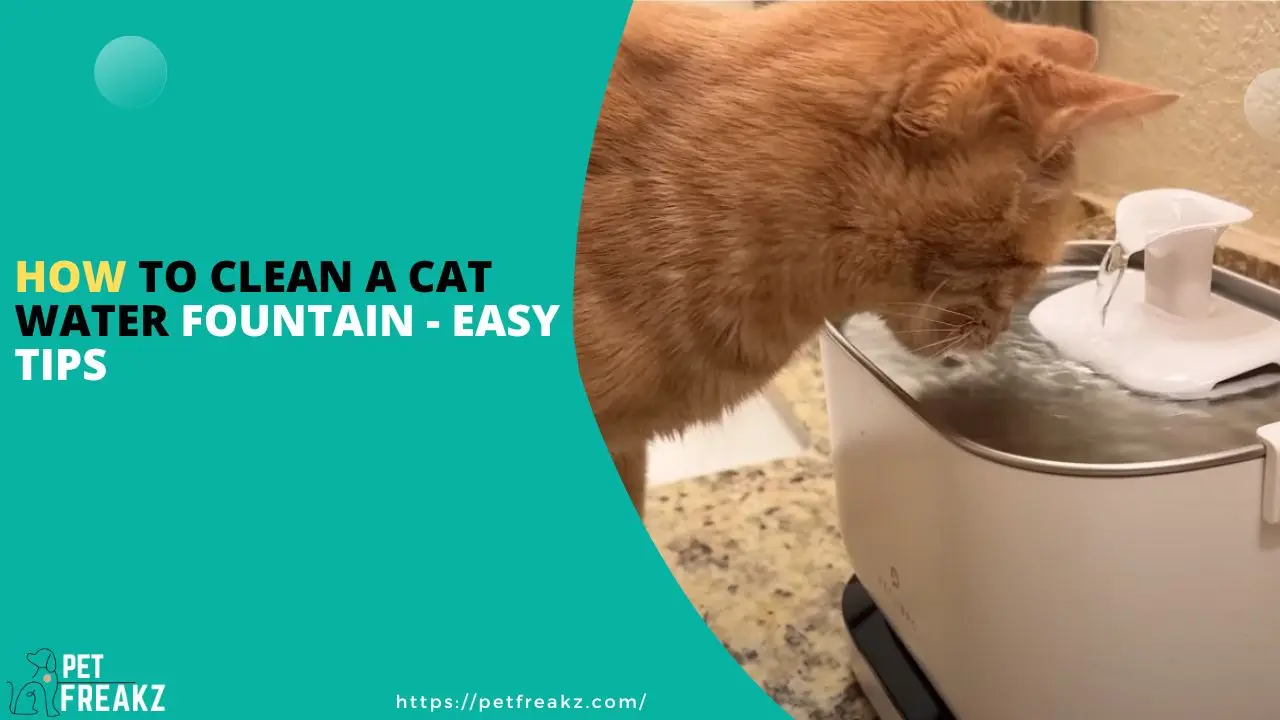Table of Contents
Cats are known for their cleanliness and grooming habits, and as responsible cat owners, it’s essential to provide them with fresh and clean water to drink. Cat water fountains are a great way to ensure a continuous supply of clean water while enticing your feline friend to stay hydrated.
However, to keep the water fountain safe and hygienic for your cat, regular cleaning is crucial. In this article, we will guide you through the step-by-step process of how to clean a cat water fountain effectively.
Why Regular Cleaning Is Essential For Your Cat’S Water Fountain
Cats are known for their cleanliness, so it’s important to provide them with a fresh and clean water source. Here are a few reasons why regular cleaning is essential for your cat’s water fountain:
- Prevention of bacterial growth: Over time, cat water fountains can become a breeding ground for bacteria. Regular cleaning ensures that harmful microorganisms are eliminated, providing your cat with safe drinking water.
- Preventing water contamination: Cats are susceptible to urinary tract infections, and dirty water can contribute to this issue. Regularly cleaning their water fountain helps prevent contamination and reduces the risk of health problems.
- Encourages hydration: Clean water is more appealing to cats. By maintaining a clean water fountain, you are encouraging them to drink more and stay properly hydrated.
- Prolongs the life of the fountain: Regular cleaning helps remove mineral deposits and debris that can clog the filters and pump. This extends the life of the fountain and ensures it continues to function effectively.
Common Contaminants That Can Build Up In A Cat Water Fountain
Cat water fountains can accumulate various contaminants that may harm your cat’s health. Here are some common ones you should be aware of:
- Hair and fur: Cats naturally shed hair, and some of it can end up in the water fountain. Regular cleaning helps remove these strands and prevents them from clogging the system.
- Dirt and debris: Dust, dirt, and other debris can find their way into the water fountain, especially if it is placed outdoors or in a dusty environment. Regular cleaning eliminates these contaminants and ensures the water remains clean and clear.
- Biofilm: Biofilm is a slimy layer that can form on the surface of the fountain and its components. It contains harmful bacteria and can affect the water quality. Regular cleaning helps prevent the formation of biofilm and keeps the water safe for your cat to drink.
- Mineral deposits: Tap water often contains minerals that can build up in the water fountain over time. These deposits can affect the taste of the water and clog the fountain’s filters. Regular cleaning helps remove these deposits, ensuring the water remains fresh and free from impurities.
Step-By-Step Guide To Clean Cat Water Fountain
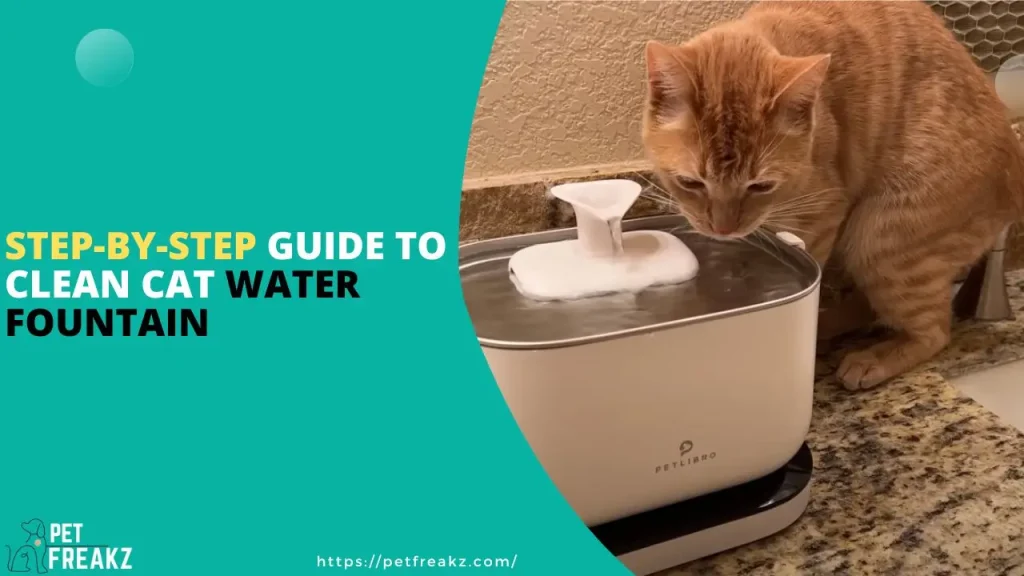
It is important to keep your cat’s water fountain clean for their health and well-being. A dirty fountain not only affects the taste of the water but can also become a breeding ground for bacteria. To ensure your cat has access to clean and fresh water at all times, follow this step-by-step guide to cleaning your cat’s water fountain.
Gathering The Necessary Cleaning Supplies
Before you start cleaning your cat water fountain, make sure you have all the necessary supplies ready. Here’s what you’ll need:
- Dish soap or pet-safe fountain cleaner
- Warm water
- Small brush or toothbrush
- Clean, lint-free cloth or paper towels
- Mild vinegar solution (optional)
Disassembling The Water Fountain For Thorough Cleaning
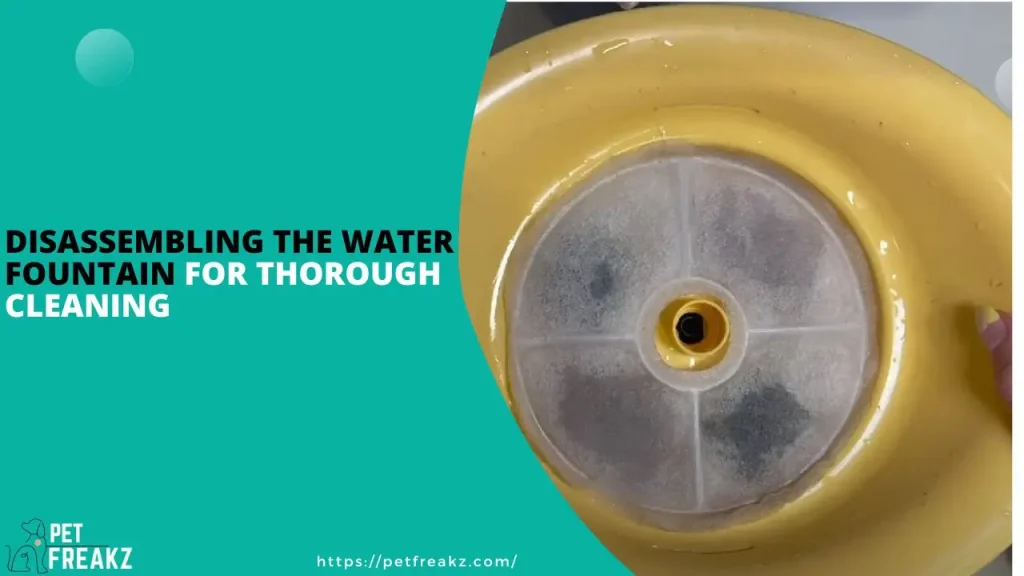
To properly clean your cat water fountain, you’ll need to disassemble it. Follow these steps:
- Unplug the fountain from the power source and remove any batteries if applicable.
- Empty the water from the fountain and discard any remaining water.
- Carefully detach the different components of the fountain, such as the pump, filters, and water reservoir, according to the manufacturer’s instructions.
- Take note of how each part is connected or take pictures to help with reassembly later.
Cleaning Each Component Of The Fountain Properly
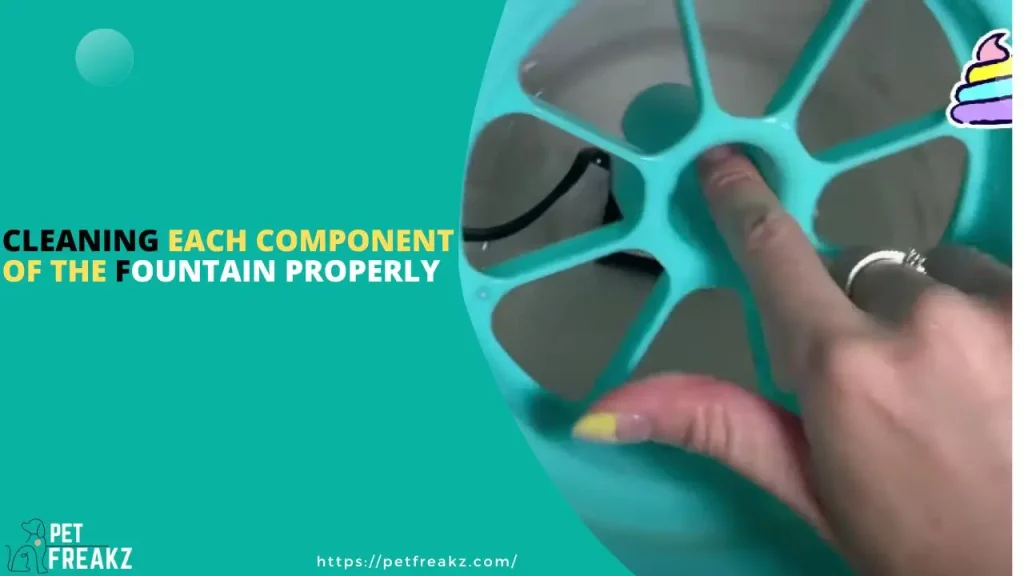
Once you have disassembled the water fountain, it’s time to clean each component thoroughly. Here’s how:
- Rinse each part with warm water to remove any loose debris or particles.
- Use a small brush or toothbrush along with dish soap or pet-safe fountain cleaner to scrub the different components, paying particular attention to any hard-to-reach areas or crevices.
- For stubborn stains or mineral build-up, you can soak the parts in a mild vinegar solution for a few minutes.
- Rinse all the components thoroughly to ensure there are no traces of soap or cleaner left behind.
Tips For Cleaning Hard-To-Reach Areas
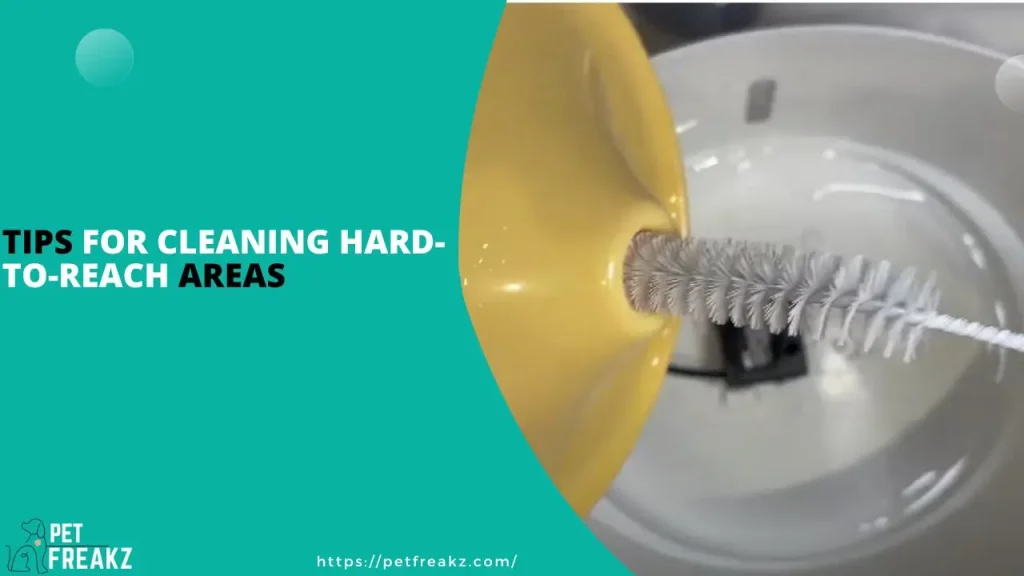
Cleaning hard-to-reach areas of your cat water fountain can be challenging but necessary. Here are some tips to make the process easier:
- Use a toothpick or cotton swab to clean narrow channels or crevices.
- Consider using a pipe cleaner or small bottle brush to reach into tight spots.
- For smaller components, you can use a mesh laundry bag or a dishwasher-safe container to hold them during the cleaning process.
Proper Drying And Reassembly Of The Fountain
To complete the cleaning process, you need to ensure all the components are thoroughly dry and the fountain is reassembled correctly. Follow these steps:
- Use a clean, lint-free cloth or paper towels to dry each part of the fountain. Make sure there is no moisture left to prevent mould or bacteria growth.
- Once dry, reassemble the fountain carefully, referring to the pictures or notes you took during the disassembly phase.
- Double-check that all the connections are secure and tight.
- Fill the fountain with fresh, clean water and plug it back into the power source or insert new batteries if required.
By following this step-by-step guide, you can ensure your cat water fountain remains clean, hygienic, and functioning optimally. Regular cleaning will ensure your feline friend has access to clean and fresh water, promoting their overall health and well-being. Keep your furry companion happy and healthy with a clean cat water fountain!
How to Clean Stainless Steel Cat Fountain
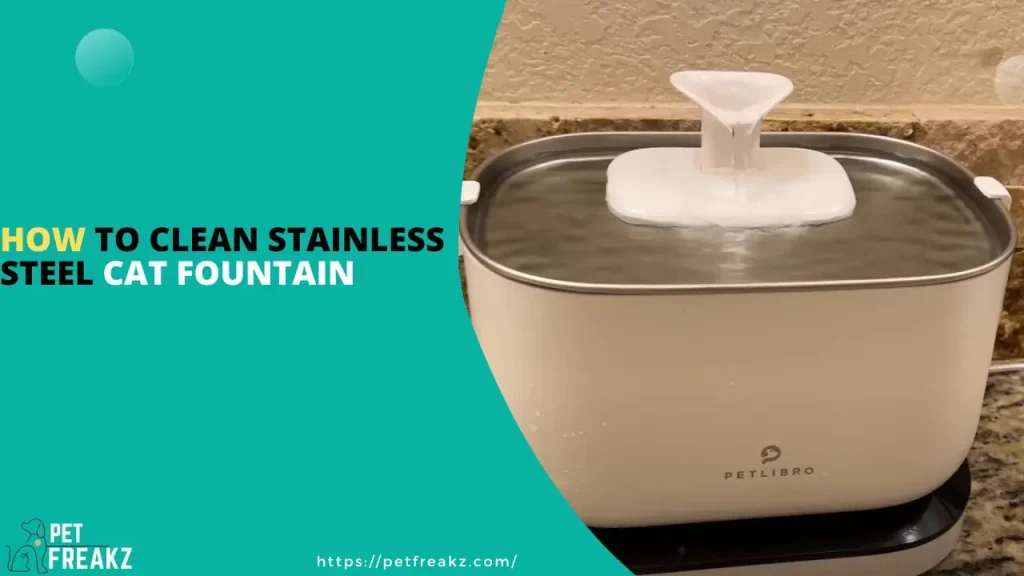
To ensure your cat’s safety and well-being, it’s important to clean its stainless steel cat fountain regularly. Follow these same steps to keep the water fresh and free from contaminants:
Gather the Necessary Supplies
Before you start cleaning the stainless steel cat fountain, gather the required supplies. You’ll need dish soap, a soft brush, a toothbrush, white vinegar, baking soda, and clean microfiber cloths. Always opt for non-toxic cleaning agents to avoid any harm to your pet.
Disassemble the Cat Fountain
Carefully disassemble the cat fountain, separating the different components. This will make it easier to clean each part thoroughly. Remove the pump, filters, and any other removable parts.
Rinse the Components
Rinse all the detachable parts under running water to remove any loose debris or cat hair. Use a gentle stream of water to avoid splashing any contaminants.
Clean the Fountain Bowl and Lid
Using a mixture of warm water and mild dish soap, clean the stainless steel bowl and lid. Gently scrub the surface with a soft brush to remove any stains or residue. Rinse thoroughly with clean water.
Clean the Pump
The pump is an essential part of the cat fountain, and keeping it clean is vital for its proper functioning. Carefully remove the pump, following the manufacturer’s instructions. Clean the pump using a toothbrush to dislodge any accumulated dirt or debris.
Clean the Filters
If your cat fountain has filters, it’s important to clean or replace them regularly. Rinse the filters under running water to remove impurities. For reusable filters, soak them in a mixture of water and white vinegar to eliminate any bacteria or odours. Rinse again with clean water before reassembling.
Use Vinegar and Baking Soda
For thorough and effective cleaning, mix equal parts of white vinegar and water. Submerge the non-electric parts of the cat fountain in this solution for 15-20 minutes. Then, sprinkle some baking soda on stubborn stains and use a soft brush to scrub them away.
Rinse Thoroughly
After cleaning with vinegar and baking soda, rinse all the components thoroughly with clean water to remove any residue and ensure there’s no lingering taste or smell.
Reassemble the Cat Fountain
Once everything is clean and dry, carefully reassemble the cat fountain, ensuring all parts are properly connected.
Refill with Fresh Water
Finally, refill the cat fountain with fresh water and turn it on to check for proper functionality. Your feline friend can now enjoy clean and filtered water once again!
How To Keep a Water Fountain Clean
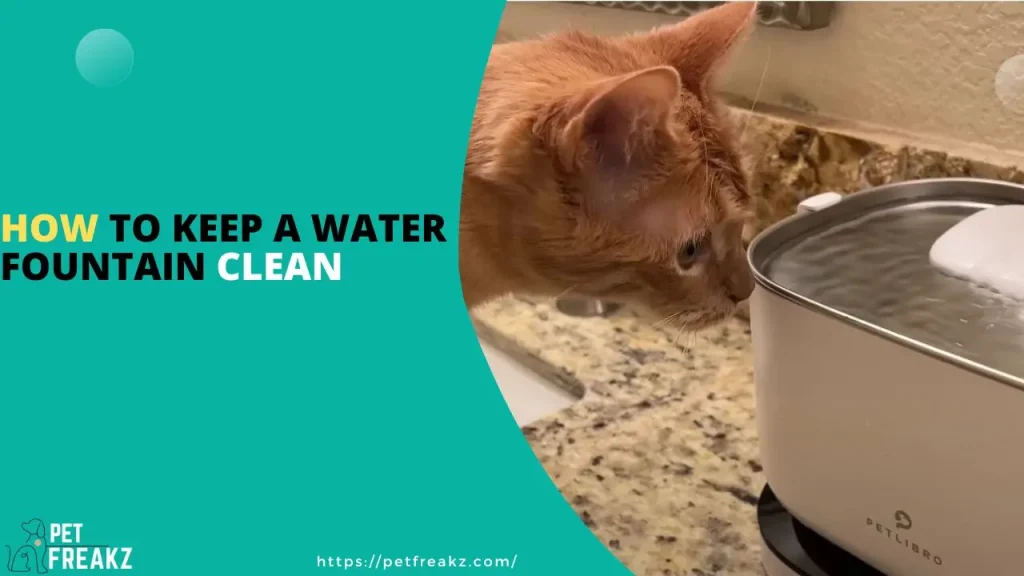
Cats need access to fresh and clean water just like humans do. That’s why investing in a cat water fountain is a great idea. Not only does it provide a constant supply of water, but it can also encourage your feline friend to drink more, which is essential for their overall health.
However, it’s important to keep the cat water fountain clean and free from any harmful bacteria. In this section, we will discuss the key points for maintaining a clean and healthy cat water fountain.
Establishing A Routine Cleaning Schedule
Keeping your cat’s water fountain clean should be a top priority to ensure your feline friend’s well-being. Here are some key points to remember when establishing a routine cleaning schedule:
- Clean the water fountain at least once a week or as per the manufacturer’s instructions.
- Take apart the fountain and thoroughly clean each component separately.
- Use a mild detergent and warm water to clean the fountain, ensuring to rinse it thoroughly to remove any soap residue.
- Scrub the hard-to-reach areas, such as crevices or corners, with a small brush or toothbrush.
- Regularly check for any signs of mould, algae, or calcium buildup, as these can contaminate the water and harm your cat.
- Consider using a pet-safe disinfectant to sanitize the fountain periodically.
Additional Tips To Prevent Bacterial Growth And Maintain Water Freshness
Apart from regular cleaning, there are a few additional tips you can follow to prevent bacterial growth and maintain the freshness of the water in your cat’s fountain:
- Change the water in the fountain daily to ensure it stays fresh and clean.
- Use filtered water to fill the fountain, as tap water may contain chemicals that can be harmful to your cat.
- Avoid placing the fountain in direct sunlight or near a heat source, as this can promote bacterial growth.
- Consider using stainless steel or ceramic fountains instead of plastic, as these materials are less likely to develop scratches or cracks where bacteria can accumulate.
- Monitor the water level regularly and ensure it doesn’t run too low, as this can cause the pump to malfunction and reduce water circulation.
- Avoid using any cleaning products that are toxic to cats, such as bleach or strong disinfectants.
How to Prevent Slime in Pet Water Fountains
One common issue that many pet owners face is slime buildup in their pet water fountains. Slime can not only affect the taste and quality of the water but also pose health risks to our furry friends.
Choose the Right Fountain Material
Choosing the right material for your pet water fountain is the first step in preventing slime buildup. Opt for materials that are resistant to bacterial growth, such as stainless steel or ceramic. These materials are non-porous and can be easily cleaned, reducing the chances of slime formation.
Regular Cleaning and Maintenance
Consistent cleaning is crucial to prevent slime in pet water fountains. Develop a cleaning routine that includes washing the fountain and replacing the water frequently. Use mild soap or pet-safe cleaning agents to ensure a hygienic environment for your pet.
Keep the Fountain in a Cool Location
Avoid placing the pet water fountain in direct sunlight or near heat sources. Warm and humid environments can promote slime growth. Instead, keep the fountain in a cool and shaded area to inhibit the growth of bacteria and algae.
Use a Water Additive
Consider using a pet-safe water additive that helps prevent slime and bacterial growth. These additives are designed to keep the water clean and fresh without compromising your pet’s health.
Opt for Filtered Water
Using filtered water in the pet fountain can significantly reduce the chances of slime formation. Filters remove impurities and contaminants from the water, making it less prone to bacterial growth.
Empty and Refill the Fountain Regularly
Stagnant water is a haven for germs and algae. Empty the fountain completely, rinse it thoroughly, and refill it with fresh water at regular intervals. This practice will keep the water clean and discourage slime buildup.
Install UV Purification Systems
Consider investing in a pet water fountain with UV purification technology. UV light can effectively kill bacteria, viruses, and algae, ensuring that your pet’s water remains free from slime and other harmful contaminants.
Add a Vinegar Solution
Using a vinegar solution is a natural and effective way to prevent slime in pet water fountains. Mix one part white vinegar with three parts water, and use this solution to clean the fountain regularly. Vinegar acts as a mild disinfectant, hindering the growth of bacteria and slime.
Monitor Water Level
Maintaining the water level in the fountain is essential to prevent slime formation. Ensure that the water level is sufficient for your pet’s needs and regularly top up the water as needed.
FAQs On How To Clean a Cat Water Fountain
How Often Should I Clean My Cat Water Fountain?
It’s recommended to clean the cat water fountain at least once a week to maintain cleanliness and water quality.
What Should I Use To Clean My Cat Water Fountain?
You can use mild dish soap and warm water to clean the cat water fountain. The use of strong chemicals or abrasive materials should be avoided.
How Do I Disassemble And Clean The Cat Water Fountain?
Start by unplugging the fountain, then carefully disassemble the parts, clean each component with soap and water, and allow them to air dry before reassembly.
Can I Clean The Cat Water Fountain In A Dishwasher?
Check the manufacturer’s instructions, as some cat water fountains may be dishwasher safe. However, many fountains need to be hand cleaned to prevent damage.
Why Is It Important To Clean My Cat Water Fountain Regularly?
Regular cleaning prevents the buildup of bacteria, mould, and debris, ensuring your cat has access to clean and fresh water for optimal health and hydration.
How long can you leave water in a cat fountain?
It’s best to change the water in a cat fountain every 2-3 days to ensure freshness and cleanliness.
Can I use vinegar to clean a cat water fountain?
Yes, you can use vinegar to clean the cat water fountain effectively and naturally.
Conclusion
Keeping your cat’s water fountain clean is essential for their health and overall well-being. Regular cleaning helps prevent the growth of bacteria and ensures your feline friend always has access to fresh, clean water. By following the steps outlined in this blog post, you can easily maintain a clean cat water fountain.
Remember to disassemble the fountain, clean each component thoroughly, and use safe cleaning agents. Additionally, creating a regular cleaning routine and replacing the filters as recommended will prolong the life of your cat’s water fountain. Taking these simple steps will not only provide your cat with a clean water source but also give you peace of mind knowing that you are promoting their optimal hydration.
So, embrace the cleaning process and prioritize the cleanliness of your cat’s water fountain for their better health.
